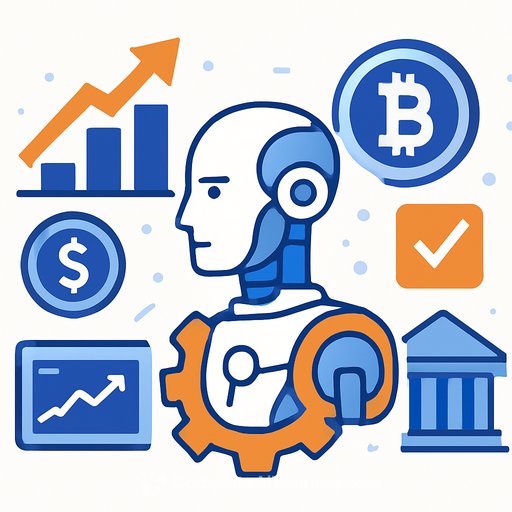How AI Transformed Business, Finance, and Crypto in 2025
2025 was the year AI moved from side project to infrastructure. According to McKinsey's The State of AI 2025, 88% of companies now use AI in at least one function, yet only about a third have wired it into the core operating model.
The biggest shift: agentic AI. These systems plan, decide, and execute multi-step tasks without constant human prompts. Roughly 23% of firms have scaled them. Another 39% are testing. That's not hype - that's adoption.
Profit impact is uneven. Only 39% of organizations saw EBIT lift tied to AI, but leaders are outpacing the field by treating AI as a growth engine, not a cost-cutting add-on. As McKinsey's Tara Balakrishnan puts it: "Focusing only on cost can limit AI's impact. Positioning AI as an enabler of growth and innovation creates space to go after the cost and efficiency improvements more effectively."
Bottom line: value follows operating model redesign, not model procurement. Talent, infra spending, and governance are the bottlenecks - and they're solvable with focus and ownership.
What this means for finance leaders
- Move from pilots to process: embed AI in approvals, pricing, risk, treasury, FP&A, and client workflows.
- Fund agentic use cases with P&L line of sight: revenue capture, faster cycle times, and new-product velocity.
- Stand up AI Ops: data contracts, evals, monitoring, rollback plans, and model lifecycle management.
- Governance first: policy, controls, and auditability ahead of scale to avoid rework and regulatory pain.
Trading and Crypto: Algorithms Set the Pace
Automation now defines execution. LiquidityFinder reports that more than 80% of global trading volume runs through algorithmic or semi-automated systems. This spans execution, risk, and forecasting - not just high-frequency plays.
Crypto moved even faster. a16z's State of Crypto flagged deep AI integration, from automated DeFi to LLM-driven token mechanics. The market for crypto trading bots alone was sized between $40.8B (2024) and $47.4B (2025), with forecasts above $54B by 2026. Broader AI trading platforms reached about $13.5B in 2025 with growth above 30%.
Research reinforces the thesis: an adaptive multi-agent Bitcoin system (arXiv, 2025) beat buy-and-hold by reacting to volatility and sentiment. Similar setups that fuse social/news signals with on-chain metrics show promise - when built and monitored well.
Caveat: algorithms can overfit, compound bad data, and trigger cascades in stress. Human judgment still matters. Even leaders like Robinhood's CEO Vlad Tenev stress supervision and accountability. The edge isn't the model alone - it's data quality, agent design, and disciplined oversight.
Playbook for desks and funds
- Data pipeline: unify market, alt, and on-chain feeds; enforce data lineage and freshness SLAs.
- Agent architecture: separate planners, executors, and risk guards; run sims before live deployment.
- Risk controls: pre-trade checks, kill switches, circuit breakers, and scenario drills (flash moves, illiquidity).
- Generalization: rolling walk-forward tests, out-of-sample evals, and drift alerts to curb overfitting.
- Human-in-the-loop: tiered approvals for size, leverage, and unusual behavior; clear escalation paths.
- Auditability: version every model/prompt/dataset; keep immutable logs for compliance and P&L attribution.
2026: From Experiments to Operating Norm
Deloitte expects a tipping point: AI projects become embedded in business models. McKinsey finds two factors correlate most with results - process redesign and structured AI governance. Firms that delay either will stall.
Expect more agentic systems for rebalancing, hedging, and real-time strategy shifts. Regulation will tighten on transparency, explainability, and accountability, consistent with the World Economic Forum's guidance.
Technical foundations decide winners: clean data, reliable compute, integration across desks, and agent orchestration. Concentration risk and error cascades remain real, especially in crypto's volatile conditions.
Build now
- Operating model: decide where AI makes the decision vs. recommends; write it into policy and controls.
- Governance: model risk for AI (use-case inventories, model cards, approvals, periodic reviews).
- Monitoring: latency, slippage, drift, constraint violations, and override rates - in real time.
- Infra strategy: cost-aware compute, caching, eval harnesses, and safe rollback.
- Talent: pair quants, data engineers, and PMs with traders and risk; train for agent thinking.
- Vendor playbook: security reviews, data usage terms, benchmarks, and exit plans.
Metrics that matter
- Trading: hit rate, slippage, Sharpe, drawdown on stress days, P&L attribution by model/agent.
- Model health: decay half-life, drift alerts, false-positive/negative rates, intervention frequency.
- Ops and cost: time-to-decision, cycle-time reduction, unit economics, infra cost per dollar of P&L.
Where to go deeper
For a grounding in adoption patterns and governance, see McKinsey's report The State of AI 2025 and the WEF's Artificial Intelligence in Financial Services 2025.
If you're scoping tools for finance use cases, explore this curated list: AI tools for finance.
The takeaway is simple: AI is now a core instrument of growth. Teams that wire it into decisions, controls, and culture - and prove it with numbers - will set the pace in 2026.
Your membership also unlocks:






